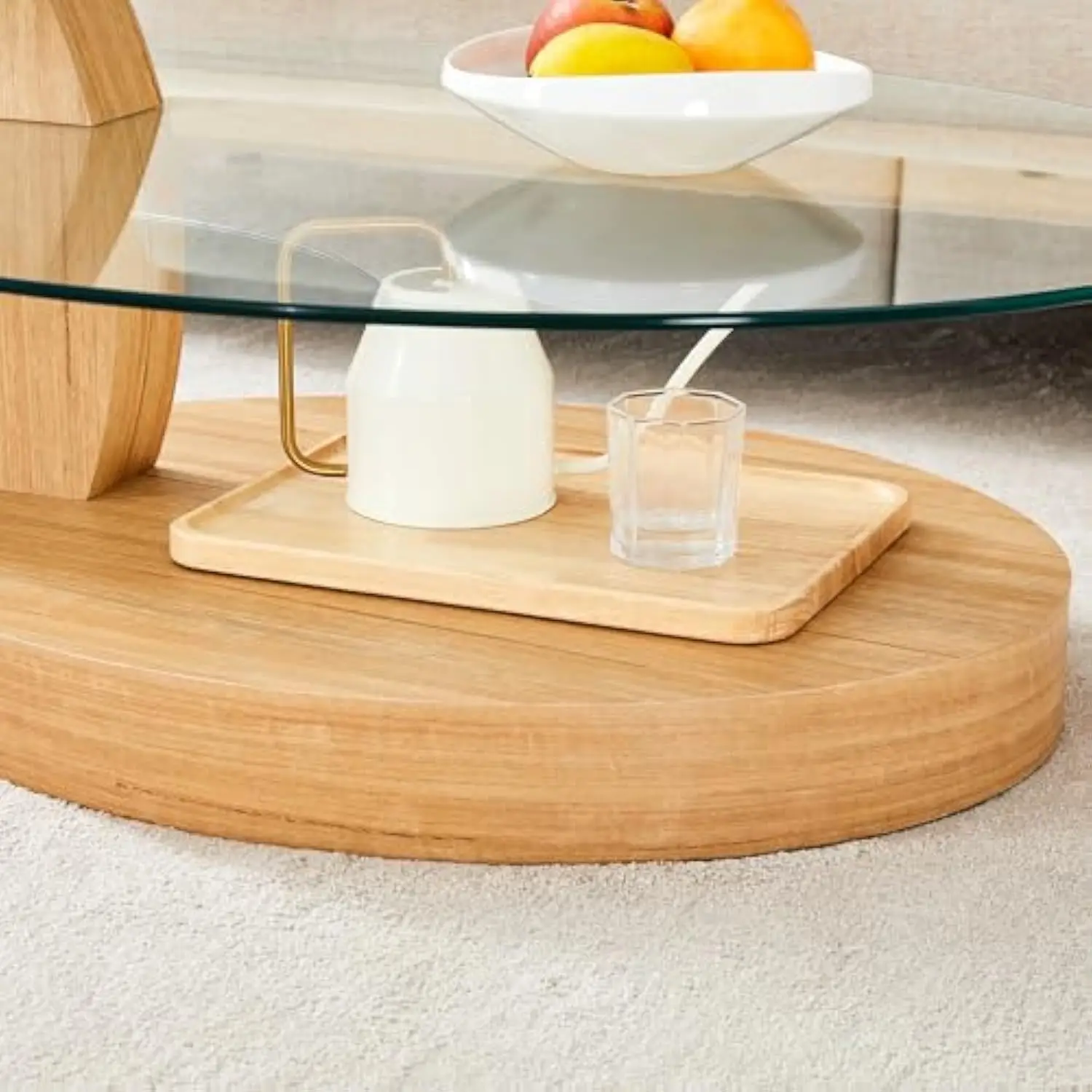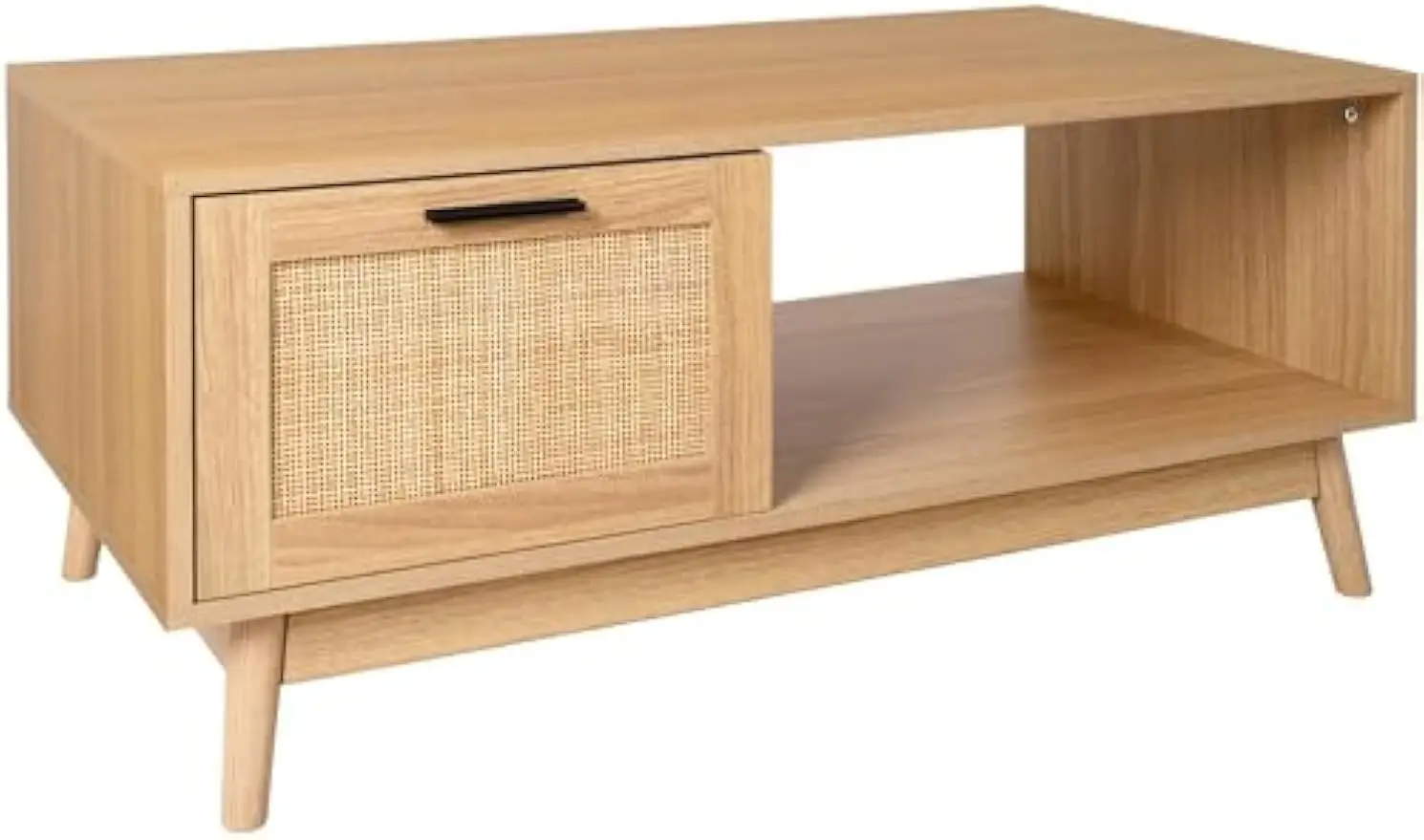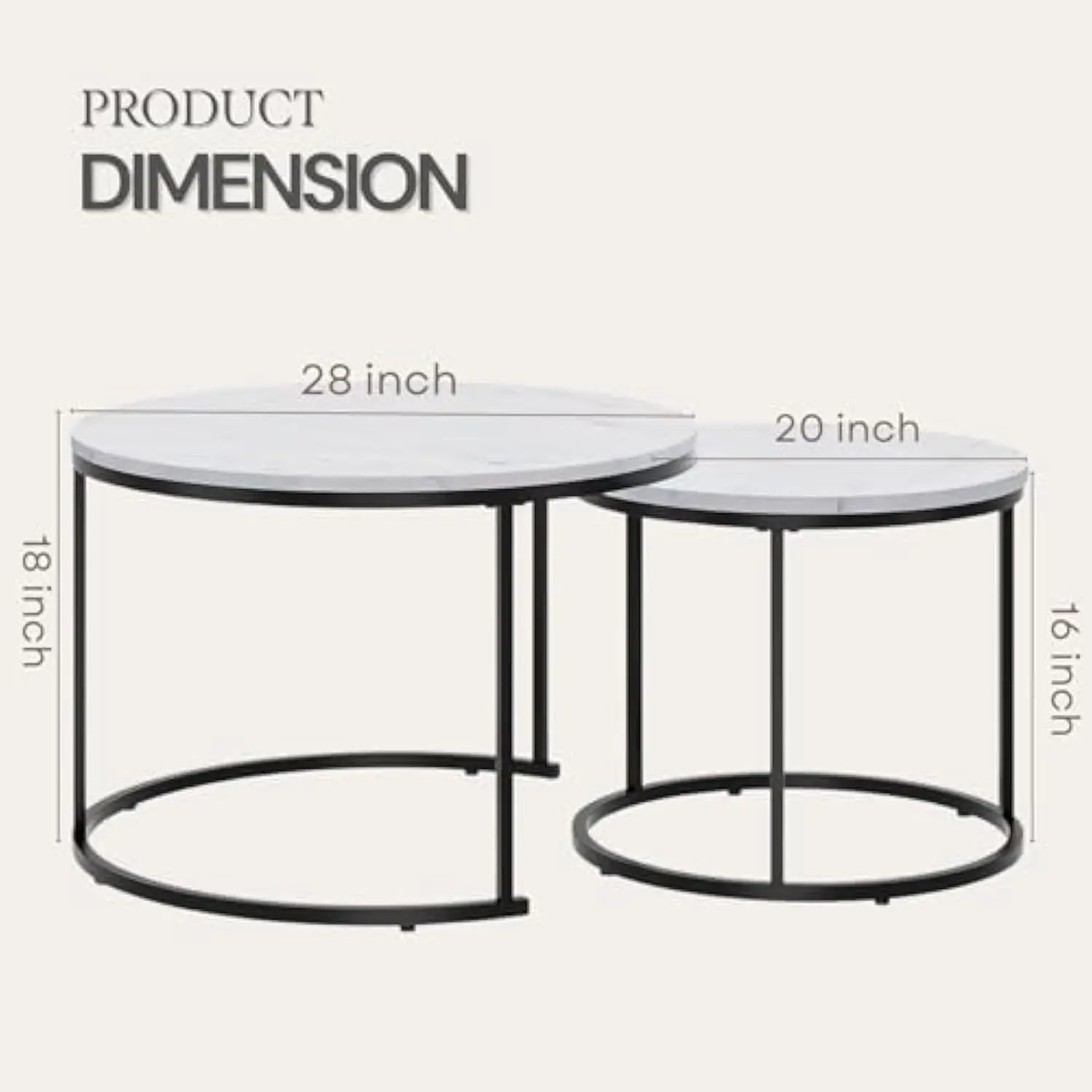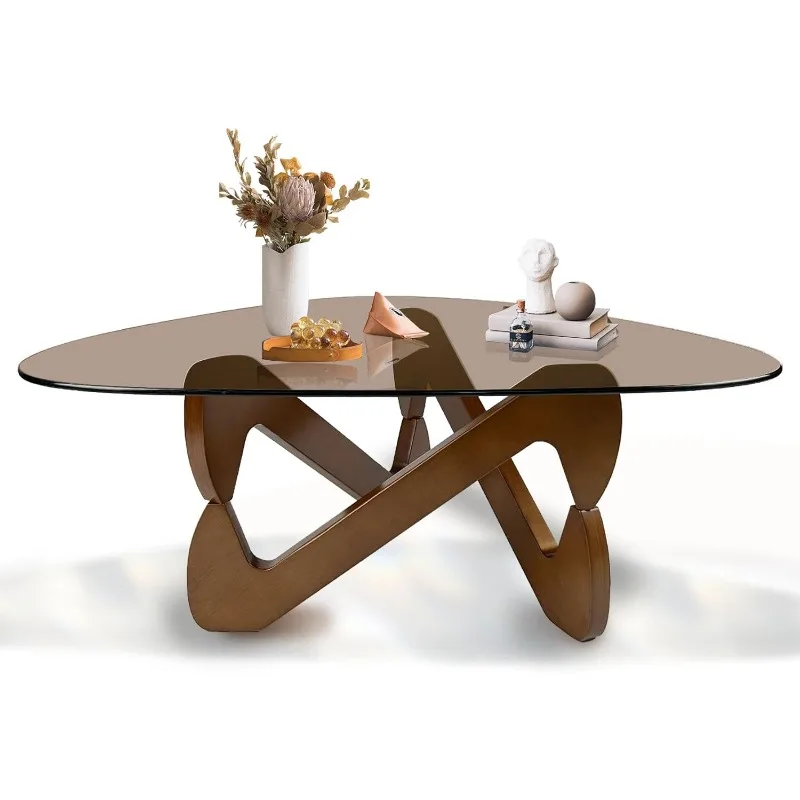Introduction: Finding Your Perfect Coffee Table
The coffee table stands as the centerpiece of any living room, acting as both a functional surface and a key design element that ties your space together. When choosing this essential piece of furniture, the material decision between glass and wood represents one of the most significant choices you’ll make. This choice affects not only the visual appeal of your room but also practical considerations like durability, maintenance requirements, and how the piece will integrate with your lifestyle.
Whether you’re drawn to the airy transparency of glass or the natural warmth of wood, understanding the full spectrum of benefits and challenges of each material is crucial to making the right choice. As design specialists with a passion for timeless mid-century modern aesthetics, Hearth Forms appreciates how the perfect coffee table can transform a living space from ordinary to extraordinary.
In this guide, we’ll explore the complete comparison of glass versus wood coffee tables, examining everything from visual impact to practical everyday use. For specific styling ideas after you make your decision, our collection of glass top coffee table ideas can provide additional inspiration.
At a Glance: Key Differences Between Glass and Wood
Before diving into detailed explanations, here’s a quick comparison of the main differences between glass and wood coffee tables:
| Feature | Glass Coffee Tables | Wood Coffee Tables |
|---|---|---|
| Aesthetics | Modern, sleek, transparent | Warm, natural, substantial |
| Durability | Scratch-resistant but can chip/break | Can scratch but highly durable overall |
| Maintenance | Frequent cleaning for fingerprints | Needs protection from moisture/heat |
| Safety | Potential breakage concerns | Generally very safe |
| Visual Weight | Light, airy appearance | More substantial presence |
| Family-Friendliness | Moderate (depends on glass type) | High (especially with rounded edges) |
| Price Range | Moderate to high | Moderate to very high |
This comparison serves as a starting point, but your individual preferences, home environment, and specific needs should guide your final decision. For instance, if you have young children or pets, you might want to explore additional glass coffee table safety tips before making your choice.
The Appeal of Glass Coffee Tables: Advantages
Visual Lightness and Spatial Illusion
One of the most compelling reasons to choose a glass coffee table is how it affects the perception of space. The transparency of glass creates an open feel that can make even smaller rooms appear more spacious. This visual lightness works particularly well in:
- Compact living rooms or apartments where space is at a premium
- Rooms with limited natural light, as glass reflects and maximizes available light
- Spaces where you want to showcase a beautiful rug or flooring underneath
Glass tables don’t visually block the room, allowing your eye to travel through the space uninterrupted. This creates an airy, uncluttered feeling that many find appealing in contemporary home design.
Modern Aesthetic Appeal
Glass coffee tables naturally complement contemporary and modern design schemes. Their sleek, clean lines offer:
- A sophisticated, elegant appearance that feels current
- Versatility to pair with various base materials like metal, wood, or stone
- The perfect canvas for highlighting the beauty of a sculptural base
- A natural fit with mid-century modern design elements when paired with the right frame
The neutral quality of glass also makes it exceptionally adaptable to changing decor styles over time. Our mid-century modern glass top coffee tables showcase how this versatile material can be incorporated into timeless designs.
Easy Cleaning of Spills
The practical benefits of glass surfaces shouldn’t be overlooked:
- Non-porous surface means liquids sit on top rather than soaking in
- Most spills can be wiped away completely with a simple cleaning
- No permanent staining from coffee rings or water marks
- Resistant to damage from most household liquids
This makes glass an excellent choice for households where entertaining happens frequently or for those who prefer minimal maintenance concerns.
The Challenges of Glass Coffee Tables: Disadvantages
Safety Considerations
While modern glass coffee tables are typically made with safety in mind, there are still some concerns to consider:
- Even tempered glass can chip at the edges if struck with force
- Sharp corners can be hazardous, especially in homes with small children
- The hardness of the surface means items dropped on it may break more easily
- Psychological discomfort for some who worry about glass durability
Tempered safety glass addresses many of these concerns, as it’s designed to break into small, less dangerous pieces if shattered, but the perception of fragility remains a consideration for many shoppers.
Maintenance Reality
Though glass resists staining, it does require regular maintenance:
- Fingerprints, smudges, and dust are highly visible on glass surfaces
- Daily wiping may be necessary to maintain a pristine appearance
- Special glass cleaners are often needed to avoid streaking
- Water spots can form if not dried properly after cleaning
For those who prefer low-maintenance furniture, the constant attention glass requires might become tiresome.

Temperature and Feel
Glass surfaces have distinct physical characteristics that might not suit everyone:
- Glass feels cool to the touch, which can seem unwelcoming in certain settings
- Items placed on glass make more noise when set down (clinking glasses or dishware)
- The hard surface isn’t comfortable for those who like to rest feet on the coffee table
- Can create a more formal atmosphere that some find less cozy or inviting
These tactile qualities affect how people interact with the piece and should be considered alongside visual aspects.
The Warmth of Wood Coffee Tables: Advantages
Timeless Natural Appeal
Wood coffee tables offer a warmth and character that many find irresistible:
- Natural variations in grain patterns ensure each piece feels unique
- The organic material brings nature indoors, creating a grounding element
- Ages beautifully, often developing more character over time
- Complements virtually any design style from rustic to refined
Whether in lighter finishes that brighten a space or deeper tones that add richness, wood has an enduring appeal that transcends passing trends. The natural beauty of solid wood coffee tables showcases why this material has remained popular throughout design history.
Durability and Longevity
Quality wood furniture is built to last:
- Resilient against everyday impacts and use
- Can be refinished if damaged, unlike many other materials
- Solid construction typically supports heavy items without concern
- Often becomes a family heirloom passed down through generations
The essential features of solid wood coffee tables often include joinery techniques and construction methods that ensure decades of use.
Design Versatility
The variety of wood options provides remarkable design flexibility:
- Available in countless species with different colors and grain patterns
- Can be finished in ways that enhance or transform its natural appearance
- Works well with mixed materials (metal accents, stone inlays, etc.)
- Fits harmoniously with both matching and contrasting wood pieces in the same room
This versatility makes wood an adaptable choice regardless of whether your style evolves over time.
Storage Solutions
Many wood coffee tables offer functional benefits beyond surface space:
- Built-in drawers provide hidden storage for remotes, magazines, and everyday items
- Open shelves showcase books, decorative objects, or baskets for organization
- Lift-top designs create impromptu work surfaces or dining areas
- Compartments help maintain a clutter-free living environment
These practical features add significant value, especially in homes where space efficiency matters.
The Considerations of Wood Coffee Tables: Disadvantages
Maintenance Requirements
Wood requires some protective care to maintain its beauty:
- Susceptible to water rings if drinks are placed directly on the surface
- Needs coasters, placemats, and other protective accessories
- May require periodic polishing, oiling, or waxing depending on the finish
- Some finishes can darken or yellow over time with sun exposure
These maintenance needs represent an ongoing commitment to preserving the table’s appearance.
Susceptibility to Damage
Despite its durability, wood can be vulnerable in specific ways:
- Can be scratched by rough objects or dented by heavy impacts
- Heat damage from hot dishes or cups may leave permanent marks
- Liquid spills need prompt attention to prevent staining or warping
- Repairs often require professional refinishing for seamless results
While minor wear often adds character, significant damage can be distressing on a beloved piece.

Visual Weight
Wood coffee tables typically have a more substantial presence:
- The solid appearance can overwhelm smaller spaces
- Dark woods particularly can feel heavy in rooms with limited light
- Requires thoughtful balance with other furniture pieces
- May not work well in rooms where a lighter, more open feel is desired
For spaces where airiness is a priority, mastering styling with glass top coffee tables might be a better approach than choosing a heavier wood piece.
Material Deep Dive: Types of Glass for Coffee Tables
Tempered Glass
Safety is a primary concern with glass furniture, which is why tempered glass has become the standard:
- Heat-treated to be approximately 4-5 times stronger than regular glass
- Designed to break into small, rounded pieces rather than sharp shards
- Available in various thicknesses, with 10-12mm being common for coffee tables
- Offers better resistance to temperature changes and impacts
This safety feature is especially important for households with children or active environments.
Frosted or Textured Glass
Beyond clear glass, alternative finishes offer practical and aesthetic benefits:
- Hides fingerprints and smudges better than transparent glass
- Provides a softer, diffused appearance that some find more appealing
- Adds visual interest through patterns, frosting, or texture
- Still maintains light-reflecting properties while offering some privacy
These options provide the benefits of glass while addressing some of its common drawbacks.
Glass Thickness Considerations
The thickness of glass significantly impacts both function and appearance:
- Thinner glass (6-8mm) appears more delicate but supports less weight
- Standard thickness (10mm) balances strength and visual lightness
- Heavier glass (12-15mm) provides substantial stability and presence
- Edges can be polished in various ways (flat, beveled, rounded) affecting both safety and style
For more inspiration on how these variations can be incorporated into different designs, explore our collection of modern glass top coffee table designs.
Material Deep Dive: Wood Varieties for Coffee Tables
Hardwoods
The most desirable wood coffee tables are typically crafted from hardwoods:
- Offer superior strength and longevity compared to softer woods
- Feature distinct grain patterns that add natural beauty
- Develop rich patinas over time that enhance their appearance
- Provide excellent stability for furniture applications
Popular hardwoods include oak, maple, cherry, and walnut, each with its own distinctive character.
Engineered Woods
Modern manufacturing has created alternatives to solid hardwoods:
- Constructed from wood layers bonded together for dimensional stability
- Resist warping better than some solid woods
- Often more affordable while still providing wood’s natural beauty
- Quality varies significantly based on construction methods
Higher-end engineered wood products can offer excellent performance when properly crafted.
Finishes and Treatments
The finish applied to wood dramatically affects both its appearance and durability:
- Matte finishes provide a contemporary look with less sheen
- Glossy lacquers offer protection and highlight the wood’s natural beauty
- Oil finishes penetrate the wood for a natural look that’s easy to touch up
- Stains can alter color while still showcasing grain patterns
Our collection of walnut coffee tables demonstrates how finish can enhance the natural character of premium hardwoods.
Design Considerations: Matching Your Space and Style
Room Size Compatibility
The size of your living area should influence your material choice:
- Glass tables create visual openness that benefits smaller spaces
- The transparency of glass allows small rooms to feel less crowded
- Wood tables provide an anchoring presence in larger rooms
- In medium spaces, consider table proportions relative to seating arrangement
Beyond material, the shape of your coffee table (rectangular, oval, round) should complement your room’s dimensions and furniture layout.
Design Style Synergy
Different materials naturally complement various design aesthetics:
- Mid-century modern spaces benefit from both materials—wood brings warmth while glass adds lightness
- Traditional rooms typically pair better with wood, especially in classic grains and finishes
- Contemporary and minimalist environments often favor glass for its clean, uncluttered look
- Eclectic styles can successfully incorporate either material or mixed-material pieces
Consider how your coffee table will interact with existing design elements in your space.
Color Palette Integration
Your choice should harmonize with your room’s color scheme:
- Wood adds a color element through its natural tone, from light maple to deep walnut
- Glass remains color-neutral but reflects surrounding colors
- Darker woods create stronger contrast in light-colored rooms
- Glass can showcase colorful rug patterns or flooring underneath
For those considering other material options, comparing marble vs wood coffee tables provides additional perspective on how different materials affect color harmony.
Practical Lifestyle Factors: Making the Right Choice
Households with Children and Pets
Family dynamics should heavily influence your coffee table material choice:
- Wood generally offers better safety with rounded corners and sturdy construction
- Tempered glass can be a safe option when properly designed with rounded edges
- Wood hides minor scratches and dents from toys or pet claws better than glass
- Glass requires more vigilance regarding fingerprints and smudges
Consider how your table will withstand the specific activities common in your household.
Entertaining and Daily Use
How you use your living space affects which material will serve you best:
- Glass offers a water-resistant surface ideal for drinks and easy cleanup after gatherings
- Wood provides a warmer, more comfortable surface for games or casual dining
- Glass shows water rings and condensation more visibly during use
- Wood requires coasters but offers a softer sound profile for setting down glasses or plates
Mid-Century Modern Solid Wood Coffee Tables, Mid-Century Modern Teak Coffee Tables
$879.95 Select options This product has multiple variants. The options may be chosen on the product pageMid-Century Modern Danish Coffee Tables, Mid-Century Modern Oval Coffee Tables, Mid-Century Modern Solid Wood Coffee Tables
$390.05 Select options This product has multiple variants. The options may be chosen on the product pageMid-Century Modern Coffee & End Table Sets, Mid-Century Modern Coffee Table Sets, Mid-Century Modern Oval Coffee Tables
Price range: $257.48 through $331.04 Select options This product has multiple variants. The options may be chosen on the product pageMid-Century Modern Glass Top Coffee Tables, Mid-Century Modern Glass Top Side & End Tables
$460.58 Select options This product has multiple variants. The options may be chosen on the product pageMid-Century Modern Glass Top Coffee Tables, Mid-Century Modern Vintage Coffee Tables, Mid-Century Modern Vintage Side & End Tables
$725.36 Select options This product has multiple variants. The options may be chosen on the product pageMid-Century Modern Lift Top Coffee Tables, Mid-Century Modern Square Coffee Tables
$454.73 Select options This product has multiple variants. The options may be chosen on the product page
Aging and Long-term Considerations
Think about how each material evolves over time:
- Quality wood develops character and patina that many find increasingly beautiful
- Glass remains unchanged, maintaining its original appearance indefinitely
- Wood can be refinished to address wear, scratches, or changing taste
- Glass typically needs replacement rather than restoration if damaged
For multi-functional options that adapt to changing needs, consider exploring our lift-top coffee tables which offer additional versatility.
Care and Maintenance: Keeping Your Coffee Table Beautiful
Glass Table Care
- Clean regularly with a glass-specific cleaner and microfiber cloth to prevent streaking
- Address fingerprints and smudges immediately for best appearance
- Use felt pads under decorative items to prevent scratching
- Distribute weight evenly for items placed on the surface
- Consider glass-specific protective products that reduce fingerprint visibility
Wood Table Care
- Dust frequently with a soft, dry cloth following the direction of the grain
- Clean spills immediately with a slightly damp cloth, then dry thoroughly
- Use coasters, placemats, and trivets to protect from moisture and heat
- Apply furniture polish or conditioner appropriate for your wood’s finish
- Position away from direct sunlight to prevent uneven fading
- Periodically check and tighten any hardware if the table has legs or components
Is a Mixed Material Coffee Table Right for You?
For those struggling to choose between glass and wood, mixed material coffee tables offer an appealing compromise. These designs typically feature:
- Glass tops paired with wood, metal, or stone bases
- Wood frames with glass inserts or panels
- Combinations that highlight the strengths of each material
- Visual interest created by material contrast
These hybrid pieces can provide the warmth and character of wood alongside the modern appeal and easy maintenance of glass surfaces. The transparency of glass components maintains visual lightness while wood elements add warmth and natural texture.

Mixed material designs often serve as versatile “bridge” pieces that work well when transitioning between design styles or combining different furniture elements. Our coffee table sets frequently incorporate thoughtful material combinations that maximize both aesthetics and functionality.
Making the Final Decision: Key Questions to Ask Yourself
To determine which coffee table material best suits your needs, consider these questions:
- What is your primary design aesthetic, and which material naturally complements it?
- Do you have young children or pets whose safety and activity should influence your choice?
- How much maintenance are you willing to perform regularly?
- Do you prefer furniture that maintains its original appearance or develops character over time?
- What other furniture pieces will your coffee table need to complement?
- Is your space small enough that visual lightness matters, or large enough to anchor with a substantial piece?
Your answers will guide you toward the material that aligns with both your practical needs and aesthetic preferences. Remember that either choice can work beautifully when selected with your specific circumstances in mind.
Common Questions About Glass and Wood Coffee Tables
How much weight can a glass coffee table typically hold?
Quality tempered glass coffee tables can typically support between 30-50 pounds when weight is distributed evenly. Always check manufacturer specifications for exact weight limits.
Can scratches in wood coffee tables be repaired?
Minor scratches in wood can often be addressed with furniture touch-up markers, paste wax, or even home remedies like rubbing a walnut over the scratch. Deeper damage may require professional refinishing.
Are there eco-friendly options for both materials?
Yes—look for wood from responsibly managed forests and glass with recycled content. Both materials can be environmentally sound choices when sourced responsibly.
Will a glass coffee table make my room look more modern?
Glass typically does convey a more contemporary feel, but design depends on the total package. A glass table with a traditional wooden base might still read as classic, while glass coffee tables in current style can definitely modernize a space.
Finding Your Perfect Coffee Table: Beyond Materials
While material choice is crucial, remember that other factors significantly impact how your coffee table functions in your space:
- Shape and size should be proportional to your seating arrangement (typically about two-thirds the length of your sofa)
- Height should allow comfortable use from adjacent seating (generally 1-2 inches lower than cushion height)
- The space between the table and surrounding furniture should allow easy movement (about 18 inches)
- Functionality features like storage, adjustable heights, or expandability might be priorities depending on your lifestyle
The perfect coffee table balances form and function, serving as both a practical surface and a design statement that elevates your entire living space. Whether you choose the natural warmth of wood or the contemporary elegance of glass, selecting a quality piece from Hearth Forms ensures your coffee table will be a central element in your home for years to come.







